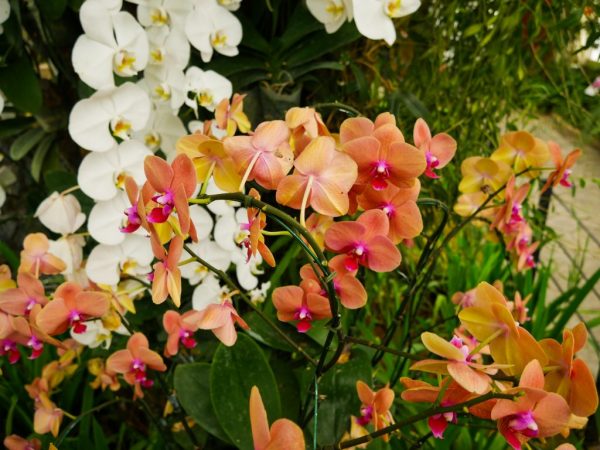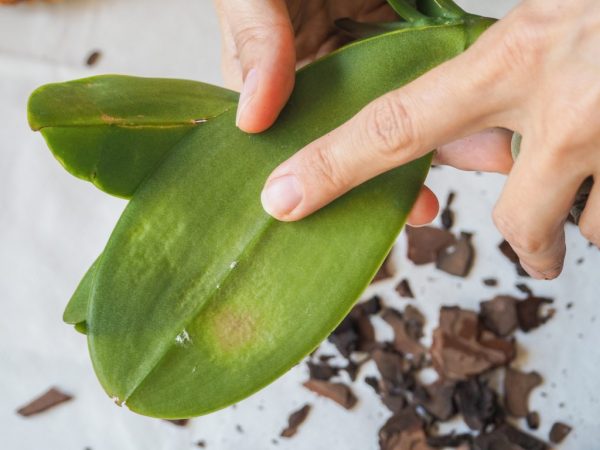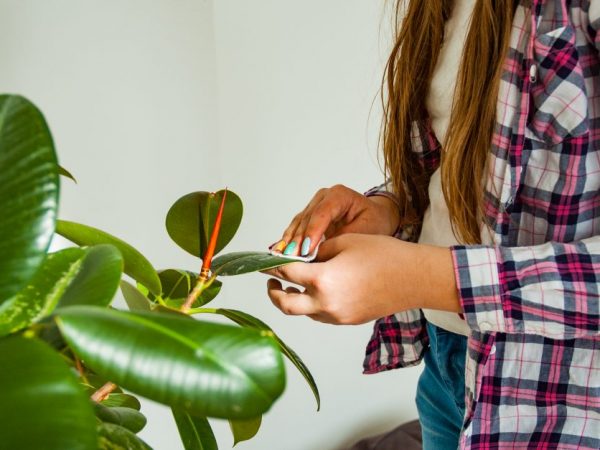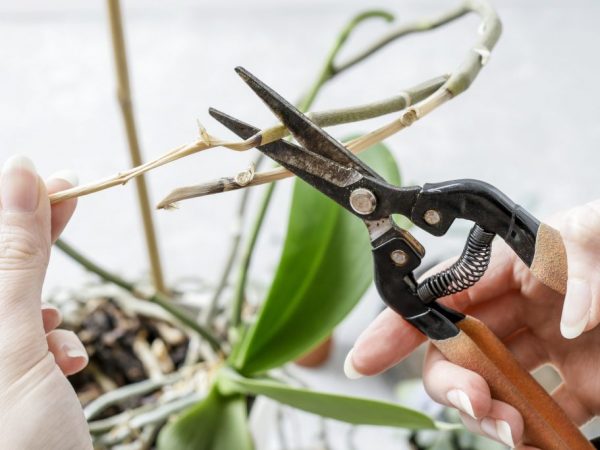Black and white spots on the orchid
Spots on orchid leaves appear when flowers are sick and indicate that the plant needs special care. The choice of method and means for treatment depends on the color of the spots. Timeliness and the right choice guarantee the preservation of the life of the phalaenopsis, which will subsequently delight with exuberant flowering.

Black and white spots on the orchid
Types and characteristics of diseases
The spots on phalaenopsis flowers are dark and light. There are such colors of defeat:
- black spots on orchid leaves;
- brown (brown) stripes and dots on the crown and trunk;
- white spots on orchid leaves.
A separate group of symptoms of the disease is distinguished by black spots that have appeared on orchid flowers.
Infection is characterized by the following criteria:
- The vastness of the affected area: huge holes, plaque or small, almost invisible points.
- Growth rate: those that grow quickly and cause rot, and those that start from a small inconspicuous point and retain their size for a long time.
- The presence or absence of rot, since traces of diseases can be wet and dry.
- Source location: in a leaf rosette, passing to the roots or appearing on the upper young leaves.
Reasons for the appearance of stains
The reasons that white or other spots appear on the trunk of an orchid or on its leaves are bacterial, viral, fungal infections.
The source of infection is most often the soil. Unsuitable conditions of detention can provoke the appearance of spots on phalaenopsis: dry or excessive humidity in the room, a dark place or short daylight hours, location close to a heat source or to cold glass. Another reason for the spread of the disease is a nearby plant infected with a virus or bacteria. That is why Phalaenopsis cannot be placed with other colors.
The treatment of the plant depends on which characteristics are most suitable for the description. The recovery period and the likelihood of re-flowering can also be predicted.
Orchid diseases and their manifestations
The most common phalaenopsis diseases, the symptoms of which are spotting of various colors, are:
- Powdery mildew, in which the leaves are covered with a white bloom emanating from the leaf rosette. Most often, the lower leaves are affected, after which the spotting spreads to the roots and stem, eating up and drying it out from the inside.
- Brown rot manifests as brown dots that quickly become wet spots. A secondary infection affects the roots, and they, together with the crown, turn into a loose, foul-smelling humus mass.
- Anthracnose, which looks like black dots on the outside of the leaves. For a long time, the disease does not manifest itself, but with the onset of winter cold and shortening daylight hours, it progresses and quickly affects the entire bush.
- Rust, manifested by light spots, initially visible only on the back of the phalaenopsis crown. When the flower weakens, the dots merge into a large dark spot, which takes on a rusty hue.
- Light burns can also cause mottling. A prerequisite for the appearance of thinning on the leaves is a violation of the rules for caring for the plant, resulting in the ingress and stagnation of moisture. Growing on a windowsill, where the scorching sun's rays fall, also provokes disease. Light and dry areas cause the leaf to dry out over time.

The most common phalaenopsis diseases
The most effective drugs
Treating white spots on orchids is difficult because the process is time consuming and requires patience. To combat ailments, they use:
- Fungicides are drugs whose action is aimed at getting rid of fungal diseases.
- Natural antibiotics are substances that can get rid of bacterial diseases, as well as biological compounds that have a general strengthening effect. All these drugs perform the task of root and foliar feeding, and are also a source of flora that can absorb pathogenic bacteria and spores of some varieties of the fungus.
- Chemicals, among which drugs of complex and targeted effects are distinguished. The most famous substances are copper sulphate and lime, which are collectively referred to as the Bordeaux mixture.
- Handy substances, which are the simplest means for disinfecting the soil or foliar feeding of plants. This includes potassium permanganate and hydrogen peroxide.
Treatment and prevention methods
The treatment to which phalaenopsis is subjected depends entirely on what kind of disease the flower is affected by. A correctly chosen set of measures allows you to avoid the death of the plant, and also contributes to the rapid restoration of the flower after getting rid of the spot of various origins.
The first thing to do when treating phalaenopsis, which have white spots or rot spots appear, is to isolate the orchid from healthy flowers.

Proper treatment avoids plant death
The complex of rehabilitation therapy includes the following activities:
- disinfection of soil in a pot;
- anti-stain treatment;
- creating proper conditions and care for the plant.
The location for the treatment must meet the requirements. It should not be too dark, since the lack of enough light weakens the phalaenopsis.
Anthracnose
Anthracosis is treated by treating phalaenopsis with crushed activated carbon. The powder is used to treat the sections and places for removing diseased shoots. The affected parts of the plants are cut off with a knife preheated over a fire. After that, the plant is sprayed with preparations containing copper.
The recovery course lasts 10 days, during which 10 treatments are required. When treating anthracnose, you should:
- limit moisture;
- provide an abundance of bright sunlight;
- stop feeding.
Rust and black mold
It is worth treating rust and black mold after removing all affected parts of the flower. The main treatment consists in spraying phalaenopsis with drugs such as:
- Mikosan;
- Ridomil;
- Topsin-M.
All preparations used to get rid of black spots on orchid leaves are suitable for combating black spots on flowers. The concentration of the solutions remains standard.

Rust and black mold are treated after removing the affected parts of the flower
Brown rot
It will be possible to defeat brown rot by repeatedly treating the infected phalaenopsis with a solution of potassium permanganate. The substance is dissolved in water until a violet hue is obtained, a cotton pad is dipped into the liquid, and then a solution is applied to the sections. All affected areas are excised before processing.
The frequency of processing is 2 times a day, and the course lasts 3 days. After treatment, the plant should be kept at rest. If rot areas do not appear within 14 days, Phalaenopsis has recovered from the disease.
Powdery mildew
To fight white spots, which are a manifestation of powdery mildew, is most effective with the help of the complex preparation "Fitosporin". It is used only as an independent therapy, because it contains live microorganisms that can absorb pathogens of bacterial diseases and aphids.
Before disinfection, all affected shoots are removed. After treatment, the plant is provided with good watering and a sufficient amount of light.
Conclusion
Phalaenopsis are delicate indoor flowers. They are demanding on conditions of detention and neighborhood. The slightest discrepancy leads to wilting, loss of buds and inflorescences, and then leads to rapid death.
Therefore, any changes in the color of the foliage, be it white, brown or black spots on an orchid, should definitely alert breeders. The latter should take measures to avoid the loss of wildly flowering tropical favorites.


